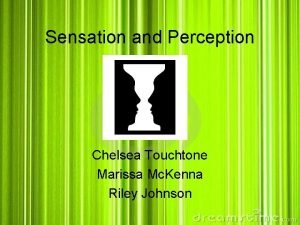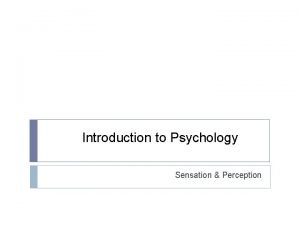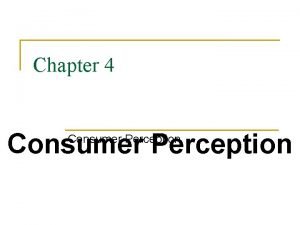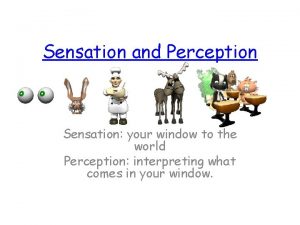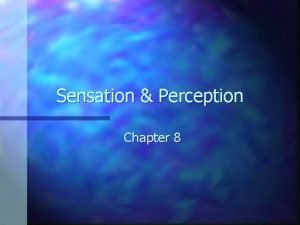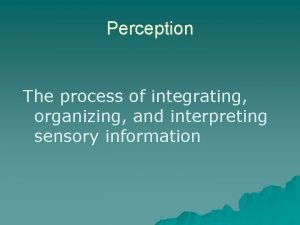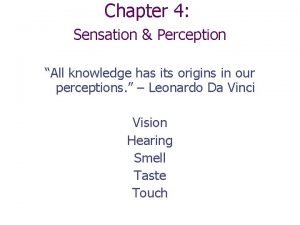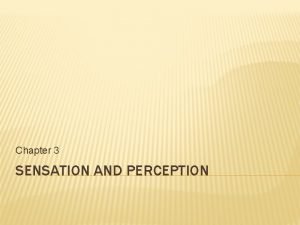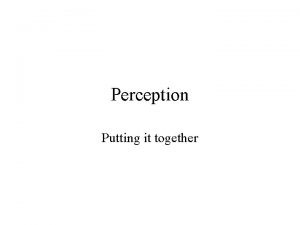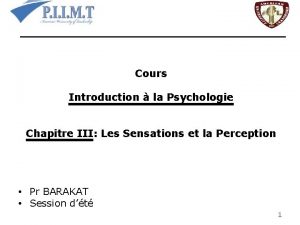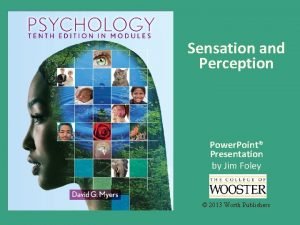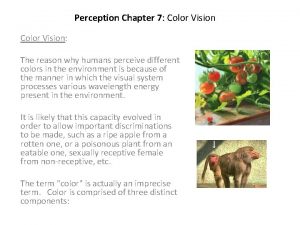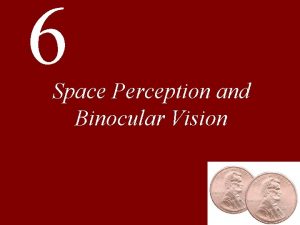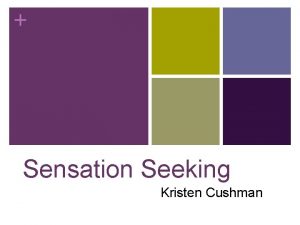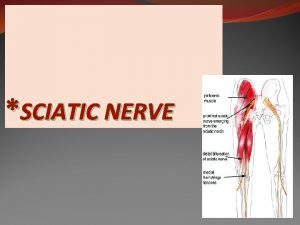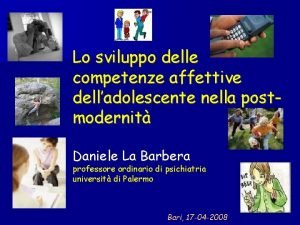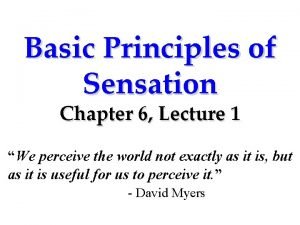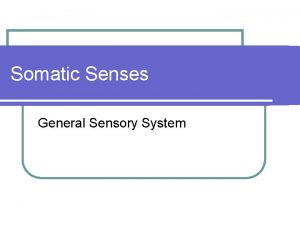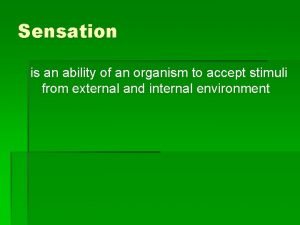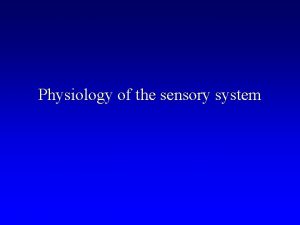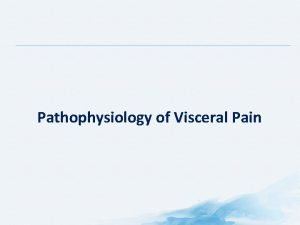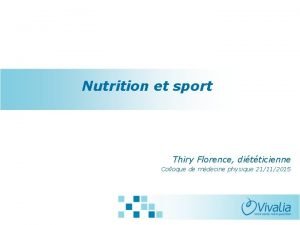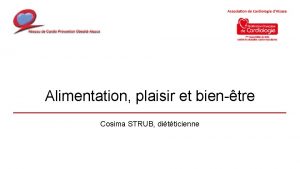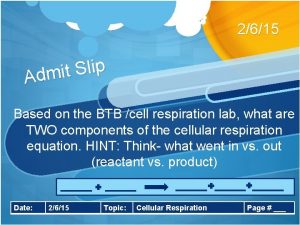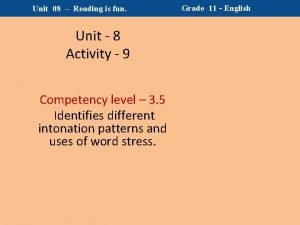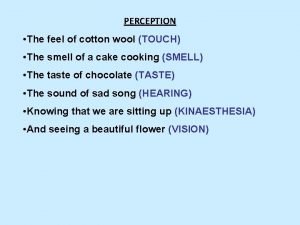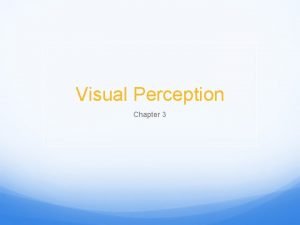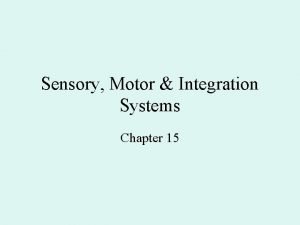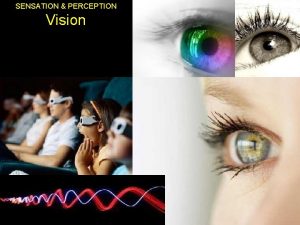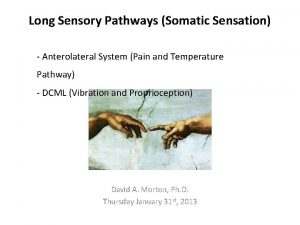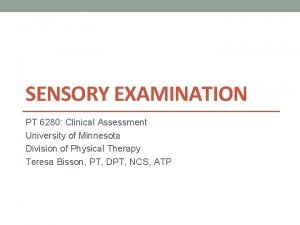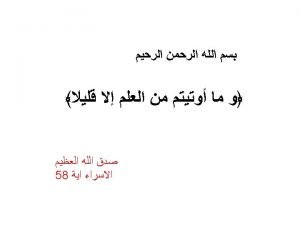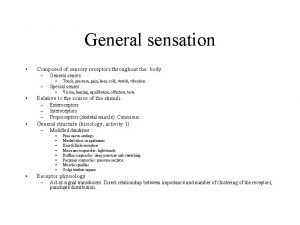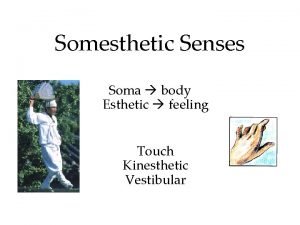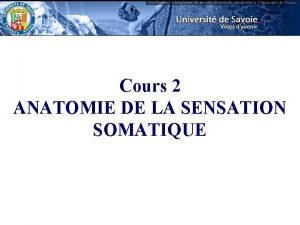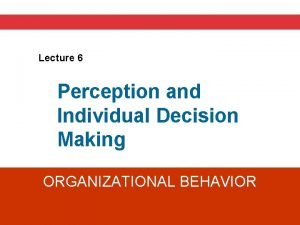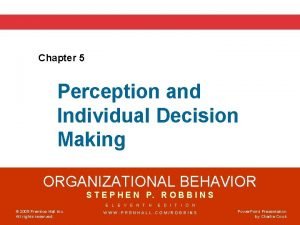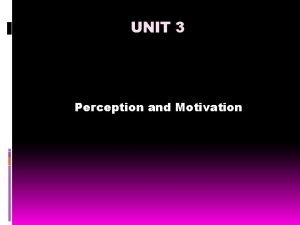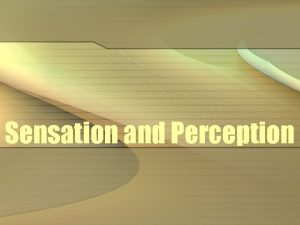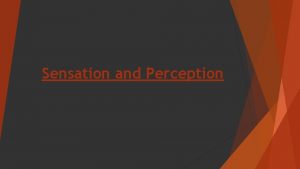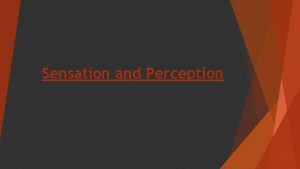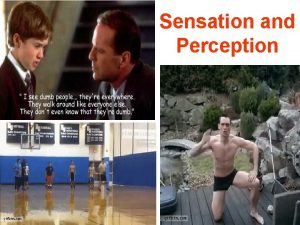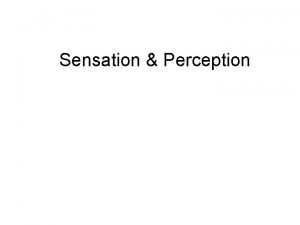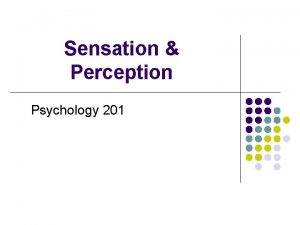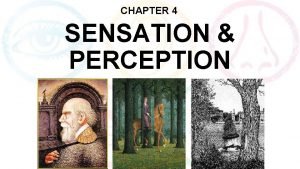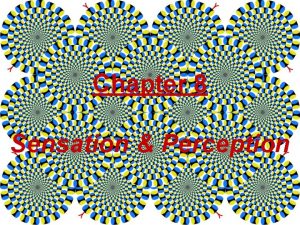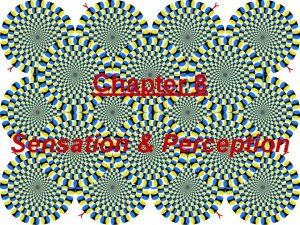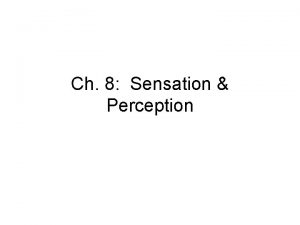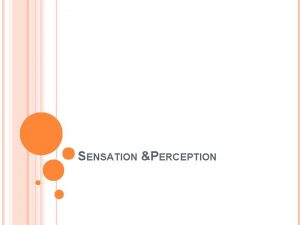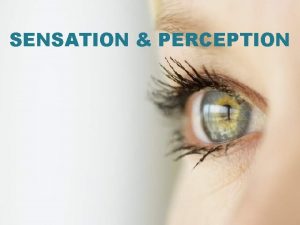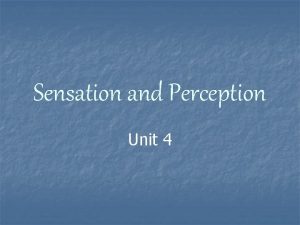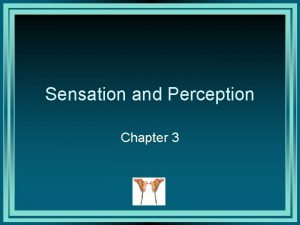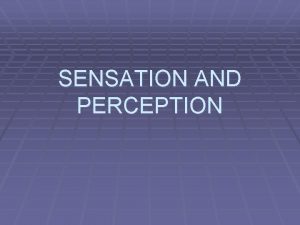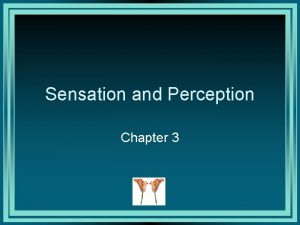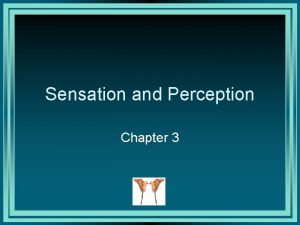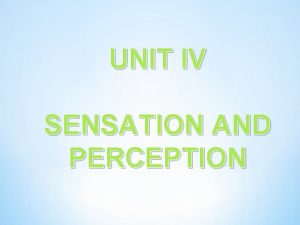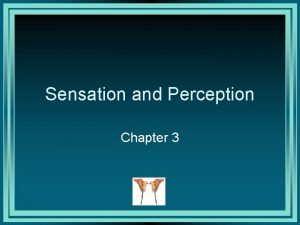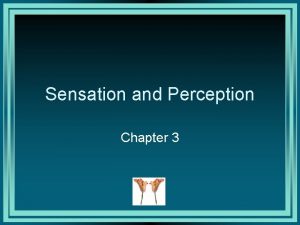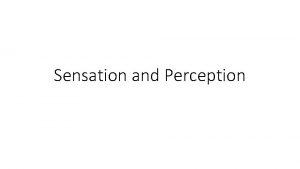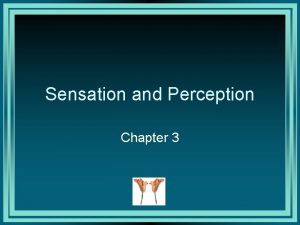Introduction to Sensation and Perception Vision Sensation Perception






















































- Slides: 54

Introduction to Sensation and Perception: Vision

Sensation & Perception How do we construct our representations of the external world? To represent the world, we must detect physical energy (a stimulus) from the environment and convert it into neural signals. This is a process called sensation. When we select, organize, and interpret our sensations, the process is called perception.

Bottom-up Processing Analysis of the stimulus begins with the sense receptors and works up to the level of the brain and mind. Think of it as data-driven. Letter “A” is really a black blotch broken down into features by the brain that we perceive as an “A. ”

Top-Down Processing Information processing guided by higher-level mental processes as we construct perceptions, drawing on our experience and expectations. Think of it as conceptually-driven THE CHT

Sensation and Perception Bottom up vs. top down? The proofreader’s illusion Wundt-Jastrow illusion Backmasking http: //jeffmilner. com/bac kmasking/

Top Down Processing Aoccdring to rscheearch at Cmbridge Uinvertisy. It deosn’t mttaer in what oredr the ltteers in a word are, the olny iprmoetnt tihng is that the frist and lsat ltteer be at the rghit pclae. The rset can be a total mses and you can still raed it wouthit a porbelm. This is bcusawe the huamn mnid deos not raed ervey lteter by istlef, but the word as a wlohe.

Likelihood Principle Herman von Helmholtz We will perceive the object that is most likely to be the cause of our sensory stimulation. That is, if a number of different objects could have caused a specific pattern of light and dark on the retina, we will perceive the object that is most likely to occur in that particular situation.

Making Sense of Complexity Our sensory and perceptual processes work together to help us sort out complex images. “The Forest Has Eyes, ” Bev Doolittle

https: //youtu. be/IGQmdo. K_Zf. Y https: //youtu. be/x. AFf. YLR_IRY

Selective Attention The focusing of conscious awareness on a particular stimulus Cocktail Party Effect: ability to tend to only one voice of many Flow: so caught up in an experience that miss out on obvious stimuli

Selective Attention and Accidents

Selective Inattentional blindness: failing to see visible objects when our attention is directed elsewhere. Change Blindness: failing to notice changes in the environment. Change deafness Choice Blindness: when the object of their preference is switched with another one, do not acknowledge the difference and tend to find explanations for this altered choice. https: //www. youtube. com/watch? v=_VPcl 04 Adh 8 https: //youtu. be/FWSx. SQsspi. Q? list=PLC 0 A 3 CAC 7 B 3 A 0 E 288 https: //youtu. be/ub. NF 9 QNEQLA http: //www. simonslab. com/videos. html

http: //channel. nationalgeographic. com/braingames/videos/choice-blindness/ Choice Blindness http: //www. dailymotion. com/video/xq 1 p 3 e_nationalgeographic-test-your-brain-episode-1 -payattention_shortfilms

Sensing the World Senses are nature’s gift that suit an organism’s needs. A frog feeds on flying insects; a male silkworm moth is sensitive to female sex-attractant odor; and we as human beings are sensitive to sound frequencies that represent the range of the human voice.

Exploring the Senses What stimuli cross our threshold for conscious awareness? Transduction: Conversion of one form of energy into another…So in Sensation it’s the transforming of stimulus energies such as sights, sounds, and smells into neural impulses our brain can interpret.

Psychophysics A study of the relationship between physical characteristics of stimuli and our psychological experience with them. Physical World Psychological World Light Brightness Sound Volume Pressure Weight Sugar Sweet

Thresholds Proportion of “Yes” Responses 0. 00 0. 50 1. 00 Absolute Threshold: Minimum stimulation needed to detect a particular stimulus 50% of the time. 0 5 10 15 20 Stimulus Intensity (lumens) 25

ABSOLUTE THRESHOLDS Vision: a single candle flame from 30 miles on a dark, clear night. Hearing: The tick of a watch from 20 feet in total quiet. Smell: 1 drop of perfume in a 3 room apt. Taste: 1 tsp. sugar in two gallons of water. Touch: The wing of a bee on your cheek, dropped from 1 cm. Why is this even important? ?

Signal Detection Theory Predicts when we will detect new weak signals. You’re driving a bus with 12 passengers. At your first stop, 6 passengers get off. At the second stop, 3 get off. At the third stop, 2 more get off, but 3 get on. What color are the bus driver’s eyes? Why do people respond differently to the same stimuli?

Subliminal Threshold: When stimuli are below one’s absolute threshold for conscious awareness. Priming: activation of certain associations-often unconsciously. http: //www. scentair. com/index. html

Difference Threshold or Just Noticeable Difference JNI To function effectively we need absolute thresholds low enough to allow us to detect important sights, sounds, textures, tastes, and smells. BUT we also need to detect small differences among stimuli. Ex. Musician tuning an instrument; sound of your friends voice in a crowded hall The minimum difference a person can detect between any two stimuli half the time.

Weber’s Law Two stimuli must differ by a constant minimum percentage (rather than a constant amount), to be perceived as different. Difference thresholds grow with the magnitude of the stimulus. Proportion varies depending on stimulus: Light: 8% Weight: 2%

Sensory Adaptation Diminished sensitivity as a consequence of constant stimulation. Put a band aid on your arm and after awhile you don’t sense it. We perceive the world not exactly as it is, but as it is useful for us to perceive it.

Sensory Adaptation Your receptor cells become less responsive after prolonged exposure to a constant stimulus Ex: cold ocean, hot shower, loud concert, music in your car nasty smells Habituation Your brain stops paying attention to things that don’t change. However, as soon as that thing changes, it recaptures your attention Ex: billboards, signs in the school, noise, posters in the room, Home plate…

Now you see, now you don’t

VISION What is the energy that we see as visible light? Transduction: In sensation, the transformation of stimulus energy (sights, sounds, smells) into neural impulses.

Both Photos: Thomas Eisner The Stimulus Input: Light Energy Electro. Magnetic Spectrum

Wavelength (Hue) Hue (color) is the dimension of color determined by the wavelength of the light. Wavelength is the distance from the peak of one wave to the peak of the next.

Wavelength (Hue) Violet Indigo 400 nm Short wavelengths Blue Green Yellow Orange Red 700 nm Long wavelengths Different wavelengths of light result in different colors.

Intensity (Brightness) Intensity: Amount of energy in a wave determined by the amplitude. It is related to perceived brightness.

Intensity (Brightness) Blue color with varying levels of intensity. As intensity increases or decreases, blue color looks more “washed out” or “darkened. ”

The Eye

Parts of the eye 1. Cornea: Transparent tissue where light enters the 2. Iris: Muscle that expands and contracts to change the size of the opening (pupil) for light. eye.

Parts of the eye 1. Lens: Focuses the light rays on the retina. 2. Retina: Contains sensory receptors that process visual information and sends it to the brain.

The Lens: Transparent structure behind the pupil that changes shape to focus images on the retina. Accommodation: The process by which the eye’s lens changes shape to help focus near or far objects on the retina.

Retina: The lightsensitive inner surface of the eye, containing receptor rods and cones in addition to layers of other neurons (bipolar, ganglion cells) that process visual information.

Optic Nerve, Blind Spot & Fovea Optic nerve: Carries neural impulses from the eye to the brain. Blind Spot: Point where the optic nerve leaves the eye because there are no receptor cells located there. Fovea: Central point in the retina around which the eye’s cones cluster. https: //www. youtube. com/watch? feature=pl ayer_embedded&v=cmhw. XXs. Js. Vc http: //www. bergen. org

COW EYE DISSECTION https: //www. youtube. com/watch? v=0 rb. Cr. Jo. Tat. E&featu re=youtu. be TIME FOR MY QUEEZY FOLKS TO TAKE A BREAK

Test your Blind Spot Use your textbook. Close your left eye, and fixate your right eye on the black dot. Move the page towards your eye and away from your eye. At some point the car on the right will disappear due to a blind spot.

Photoreceptors E. R. Lewis, Y. Y. Zeevi, F. S Werblin, 1969

Bipolar & Ganglion Cells Bipolar cells receive messages from photoreceptors and transmit them to ganglion cells, which converge to form the optic nerve.

Visual Information Processing Optic nerves connect to the thalamus in the middle of the brain, and the thalamus connects to the visual cortex.

Ross Kinnaird/ Allsport/ Getty Images Feature Detection Feature detector nerve cells in the visual cortex of the occipital lobe respond to specific features, such as edges, angles, and movement. They receive information from specific ganglion cells. They then pass the info. on to supercells in other cortical areas that respond to more complex problems. Ex. Temporal Lobe-enables you to perceive faces. We use 30% of our cortex to recognize faces.

Shape Detection Ishai, Ungerleider, Martin and Haxby/ NIMH Specific combinations of temporal lobe activity occur as people look at shoes, faces, chairs and houses.

Visual Information Processing of several aspects of the stimulus simultaneously is called parallel processing. The brain divides a visual scene into subdivisions such as color, depth, form, movement, etc. (unlike a computer that does “Serial processing”)

Motion Aftereffects http: //www. michaelbach. de/ot/mot_adapt. Spiral/index. html Are caused by the adaptation of motion-specific detectors that are tuned to the direction of the movement of the stimuli being viewed.

Tim Bieber/ The Image Bank From Sensation to Recognition

Color Vision Trichromatic theory: Young and von Helmholtz suggested that the eye must contain three receptors that are sensitive to red, blue and green colors. http: //phet. colorado. edu/simulations/sims. php? sim=Colo r_Vision#topics Standard stimulus Comparison stimulus Max Medium Low Blue Green Red

Trichromatic Color Theory Any color can be created by combining the lightwaves of 3 primary colors –red, blue, green. 64% respond to red 33% respond to blue 2 -3% respond to green When we stimulate combinations of these cones, we see other colors. For example, there are no receptors especially sensitive to yellow—when the cones we have are stimulated to varying degrees, we see yellow

Color Deficiency Genetic disorder in which people are blind to green or red colors. This supports the Trichromatic theory. Ishihara Test

COLOR BLINDNESS Most people with color–deficient vision are not color blind. They simply lack functioning red OR green sensitive cones.

OPPONENT PROCESS THEORY Trichromatic Theory does not solve all issues with color vision. BUT those blind to red and green can often still see yellow? For example, we see yellow when mixing red and green light. Clue found by Hering (a physiologist) when looking at afterimages.

Opponent Colors Gaze at the middle of the flag for about 30 Seconds. When it disappears, stare at the dot and report whether or not you see Britain's flag.

WHY? When you stare at a green square for a while, then look at a white sheet of paper—you see RED—its opponent color. Opponent Theory says there must be two additional processes-one responsible for green vs. red and one responsible for blue vs. yellow (later also added white vs black).
 Chapter 5 sensation and perception
Chapter 5 sensation and perception Gestalt principle of visual perception
Gestalt principle of visual perception Ap psych sensation and perception
Ap psych sensation and perception Sensation vs perception
Sensation vs perception Sensation and perception crossword review
Sensation and perception crossword review Chapter 3 sensation and perception
Chapter 3 sensation and perception Sensation and perception
Sensation and perception Chapter 6 sensation and perception
Chapter 6 sensation and perception Psychology chapter 4 sensation and perception
Psychology chapter 4 sensation and perception Consumer perception definition
Consumer perception definition Webers law
Webers law Sensation and perception
Sensation and perception Chapter 6 sensation and perception
Chapter 6 sensation and perception Chapter 6 sensation and perception
Chapter 6 sensation and perception Sensation and perception uu
Sensation and perception uu Chapter 4 sensation and perception
Chapter 4 sensation and perception Chapter 3 sensation and perception
Chapter 3 sensation and perception Perception vs sensation
Perception vs sensation Exposé sur la sensation en psychologie
Exposé sur la sensation en psychologie Perception vs sensation
Perception vs sensation Sensation vs perception
Sensation vs perception Chapter 7 vision and perception
Chapter 7 vision and perception Binocular vision and space perception
Binocular vision and space perception Chapter 7 managing risk vision and perception
Chapter 7 managing risk vision and perception Cs766
Cs766 Sensation seeking
Sensation seeking Sciatic nerve roots
Sciatic nerve roots Sensation seeking significato
Sensation seeking significato Principles of sensation
Principles of sensation Exteroceptors
Exteroceptors Types of sensation
Types of sensation Classification of sensation
Classification of sensation Viscerosomatic levels
Viscerosomatic levels Ditticienne base sur coute sensation
Ditticienne base sur coute sensation Ditticienne base sur coute sensation
Ditticienne base sur coute sensation What causes the burning sensation in your muscles
What causes the burning sensation in your muscles Reading 08
Reading 08 Walking on cotton wool sensation
Walking on cotton wool sensation Perception gestalt principles
Perception gestalt principles Sensation
Sensation Opponent process theory vs trichromatic theory
Opponent process theory vs trichromatic theory Dcml sensation
Dcml sensation Jung thinking feeling sensing intuiting
Jung thinking feeling sensing intuiting Cortical sensations
Cortical sensations Merkel disc receptor
Merkel disc receptor Nociceptive sensation
Nociceptive sensation Tectorial membrane
Tectorial membrane Kinesthesis and vestibular sense
Kinesthesis and vestibular sense Sensation somatique
Sensation somatique Papi kostick interpretation
Papi kostick interpretation Perception and individual decision making
Perception and individual decision making A subjective perception of vitality and feeling well
A subjective perception of vitality and feeling well What they see
What they see Subjective perception of vitality and feeling well
Subjective perception of vitality and feeling well Motivation and perception
Motivation and perception




